2002 Spectacular documented reliquary with stigmata relic of St. Padre Pio of Pietrelcina
Large gilt wood glass-fronted reliquary frame housing the first-class ex panno a stigmatibus cruentato (from a cloth bloodied by the stigmata) relics of St. Padre Pio. A very large fragment of the cloth relic is affixed under a portrait of the Saint to a red silk ground profusely decorated with an elaborate gilt paperolle ornamentation and identified in Latin on a typeset cedula label as Ex Panno a Stig. Cruentato S. Pii a Pietrelcina (from a cloth bloodied by the stigmata of Saint Pio of Pietrelcina). On the back, the frame is secured with a crisscrossed red silk ribbon, held in place by four seals of red Spanish wax bearing an imprint of a coat of arms of the Congregation of Missionary Sons of the Immaculate Heart of the Blessed Virgin Mary (Known as the Claretian Missionaries). The relic is accompanied by the original matching authentics document issued by the Postulator General of the Order on June 16, 2002 - on the very day of his canonization.
- ID# 71-RSJPR-6
- Size Frame: 14 1/2 x 12 inches (31 x 37 cm), relic: 20 x 15 mm
- Age ca. 2002
- Origin Rome, Italy
- Materials Wood, silk, paper, Spanish wax
- Price (RESERVED)
Fancy gold reliquary theca with relics of Christ's Passion - Holy Shroud & Blood
An oval fancy and unique glass-fronted pendant reliquary theca made of solid gold housing two precious relics of the Christ's Passion: the Holy Shroud of Christ and the Veil of the Blessed Virgin Mary soaked in Holy Blood of Christ. Sizable relics are affixed to the ground of red silk surrounded by gold paperolle ornamentation and identified in Latin on a bi-color manuscript cedula labels as De Velum B.M.V. Imbuto Sanguinis Dni Ntri Jesu Christi // De Sancto Sindone in quo involuto fuit corpus Dni Ntri Jesu C. (From the Veil of the Blessed Virgin Mary soaked in Blood of Our Lord Jesus Christ // Of the Holy Shroud in which the body of Our Lord Jesus Christ was wrapped). On the back, the reliquary is secured with a seal of red Spanish wax bearing an imprint with a coat of arms of Bishop Felice Cantimorri O.F.M. Cap. (†1870), Bishop of Parma, Italy (1854–1870). The reliquary is housed in its original leather clad velvet lined case of issue.
- ID# 349-RSCR-15
- Size 42 x 37 mm
- Age ca. third quarter of the 19th century
- Origin Parma, Italy
- Materials 18-karat (750) gold, silk, silver, paper, Spanish wax
- Price SOLD!
-

-

Rare documented reliquary theca with relics of the Martyrs of Casamari
Extremely rare large glass-fronted metal reliquary theca housing the first-class Ex Ossibus (of the bone) relics of six Eucharistic Martyrs of Casamari. The relics are affixed to a ground of red silk and identified in Latin on a bi-color typeset cedulae labels. On the back, the theca is secured with a seal of red Spanish wax bearing an imprint of the Postulator General of the Cistercian Order. The reliquary is accompanied by the original matching authentics document issued and sealed by the order of the Postulator General of the Order on March 20, 2025.
- ID# 72-RSJSR-3
- Size 3 x 4 1/4 inches (7.5 x 11 cm)
- Age ca. 2025
- Origin Veroli, Italy.
- Materials metal, glass, silk, paper, Spanish wax
- Price Price upon request
2005 Documented reliquary monstrance with a relic of Maronite St. Charbel Makhlouf, O.L.M
An attractive small glass-fronted gilt-metal reliquary monstrance housing the first-class ex ossibus (of the bone) relic of a Maronite Saint Charbel Makhlouf. Under a portrait of the Saint, a substantial relic is affixed to a red silk ground surrounded by paperole ornamentation and identified in Latin on a bi-color typeset cedula label as Ex Oss. S. Charbel Makhlouf (of the bone of Saint Charbel Makhlouf). On the back, under a protective cap, the reliquary is secured with a seal of red Spanish wax bearing an imprint of a coat of arms of the Postulator General of the Lebanese Maronite Order. The reliquary is accompanied by the matching authentics document issued and signed by the Postulator General on July 24th, 2005 (the day of his Feast).
This item is appropriate for private and public veneration.
- ID# 79-RSJPR-25
- Size 6 inches (15 cm) high
- Age ca. 2005
- Origin Rome, Italy
- Materials metal, glass, silk, paper, Spanish wax
- Price $7,250
2005 Documented reliquary monstrance with a relic of Maronite St. Charbel Makhlouf, O.L.M
Attractive small glass-fronted gilt-metal reliquary monstrance housing the first-class ex ossibus (of the bone) relic of a Maronite Saint Charbel Makhlouf. Under a portrait of the Saint, a substantial relic is affixed to a red silk ground surrounded by paperole ornamentation and identified in Latin on a bi-color typeset cedula label as Ex Oss. S. Charbel Makhlouf(of the bone of Saint Charbel Makhlouf). On the back, under a protective cap, the reliquary is secured with a seal of red Spanish wax bearing an imprint of a coat of arms of the Postulator General of the Lebanese Maronite Order. The reliquary is accompanied by the matching authentics document issued and signed by the Postulator General on July 24th, 2005 (the day of his Feast).
This item is appropriate for private and public veneration.
- ID# 78-RSJPR-25
- Size 6 3/4 inches (17 cm) tall
- Age ca. 2005
- Origin Rome, Italy
- Materials metal, glass, silk, paper, Spanish wax
- Price SOLD!
Russian Icon - Christ Pantocrator in brass revetment cover
Christ Pantocrator is one of the most common subjects in Russian iconography, and its iconography follows a traditional pattern. In these icons, Christ is depicted as a powerful and majestic figure, with his right hand raised in blessing and his left hand holding an open book of the Gospels. The term "Pantocrator" means "Almighty" or "Ruler of All," and the image of Christ in this role conveys his power and authority as the divine judge and ruler of the world. The icon portrays Christ with a stern expression, indicating his righteous judgment and the seriousness of his message. The icon's composition features Christ's head and shoulders in the center of the image, with his body slightly turned to the right. He is shown wearing a red tunic and blue mantle, with his long hair and beard flowing around his face. The Gospels are opened on Matthew 11:28 “Come unto me, all ye that labor and are heavy laden, and I will give you rest.”
Overall, the iconography of Christ Pantocrator is a powerful and striking representation of Christ's authority and judgment and a reminder of the spiritual power and majesty of the Christian faith.
- ID# 21-1433-012-131-SP3
- Size 10 1/4 x 8 1/2 inches (26 x 22 cm)
- Age ca. 19th century
- Origin Central Russia
- Materials Egg tempera on gessoed board in silver revetment cover
- Price $975
-

Russian Icon - St. Nicholas, the Wonderworker of Myra in brass revetment cover
Saint Nicholas the Wonderworker and Bishop of Myra (†343), was a historic 4th-century Saint and Greek Bishop of Myra. Because of the many miracles attributed to his intercession, he is also known as Nikolas the Wonderworker. He had a reputation for secret gift-giving, such as putting coins in the shoes of those who left them out for him, and thus became the model for Santa Claus. His reputation evolved among the faithful, as was common for early Christian saints.
Saint Nicholas is the patron Saint of sailors, merchants, archers, thieves, children, and students in Greece, Belgium, France, Romania, Bulgaria, Georgia, Albania, Russia, the Republic of Macedonia, Slovakia, Serbia, and Montenegro. He is also the patron saint of Aberdeen, Amsterdam, Barranquilla, Bari, Beit Jala, Fribourg, Huguenots, Kozani, Liverpool, Paternopoli, Sassari, Siggiewi, and Lorraine. His feast day is 6 December.
- ID# 26-2075-014-309-SP3
- Size 10 1/2 x 8 1/2 inches (27 x 22 cm)
- Age ca. 19th century
- Origin Central Russia
- Materials Egg tempera on gessoed wood in silvered brass revetment cover
- Price $975
-

Russian Icon - Our Lady of Kazan in brass revetment cover
Our Lady of Kazan is a holy icon of the highest stature within the Russian Orthodox Church and is considered a palladium of Russia for centuries until its theft and likely destruction in 1904. The icon represents the Virgin Mary as the protector and patroness of the city of Kazan. It is a close-up variant of the Hodegetria (Directress) style, it is noted mainly for the Child standing, with the Virgin chest length. The Kazan icons are traditionally small, following the original. The Kazan icon was very popular in Russia, especially as a wedding gift, and many copies were made in the design of the original. Two major Kazan Cathedrals, in Moscow and St. Petersburg, are consecrated to Our Lady of Kazan, as are numerous churches throughout the land. Her feast days are July 21 and November 4.
- ID# 22-10572-101-068-SP3
- Size 10 1/4 x 8 1/2 inches (26 x 22 cm)
- Age ca. Late 19th century
- Origin Central Russia
- Materials Egg tempera on gessoed board in brass revetment cover
- Price $775
-

Russian Icon - Our Lady of the Sign in brass revetment cover
Our Lady of the Sign is one of the most beloved Russian miracle-working icons of Theotokos. The icon depicts Her during the Annunciation at the moment of saying, "May it be done to me according to your word." (Luke 1:38). The Virgin Mary is depicted frontally half-length, with her hands raised in a praying position, and the Child Jesus within a round aureole upon her breast representing him at the moment of his conception. The term Virgin of the Sign is a reference to the prophecy of Isaiah 7:14: "Therefore the Lord himself shall give you a sign; Behold, a virgin shall conceive, and bear a son, and shall call his name Immanuel."
- ID# 23-6520-055-051-SP3
- Size 10 1/4 x 8 1/3 inches (26 x 21 cm)
- Age ca. Late 19th century
- Origin Central Russia
- Materials Egg tempera on gessoed board in brass revetment cover
- Price $775
-

Russian Icon - Our Lady of Joy to All Who Sorrow in brass revetment cover
Mother of God, Joy to All Who Sorrow of Moscow is the name of a famous wonderworking Russian Orthodox icon. The icon dates to a miracle that occurred on October 24, 1688, when a woman named Euphemia received healing from sickness after obeying a voice telling her to find this icon and have the priest celebrate a prayer with the blessing of water. The design of this icon depicts the Mother of God, depicted full-figured, standing with her Son in Heaven and God the Father above her in the clouds. Along both sides of the icon, framing the Mother of God, depicted are many suppliants asking for her intercession. The tenderness and kindness of a loving mother are evident in her face as She stands in paradise and yet among us.
- ID# 24-3915-027-156-SP3
- Size 12 1/4 x 10 1/2 inches (31 x 27 cm)
- Age ca. Late 19th century
- Origin Central Russia
- Materials Egg tempera on gessoed board in brass revetment cover
- Price $725
-

The web site showing only a sample of our entire inventory, if you don't see what you are looking for, please contact us.

Learn about our Unconditional Lifetime Guarantee and No Questions Asked 30-day return policy.





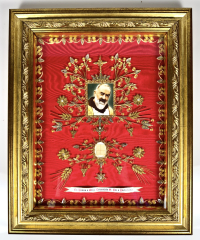
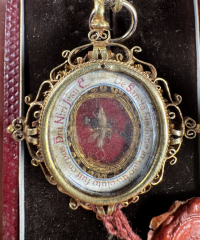
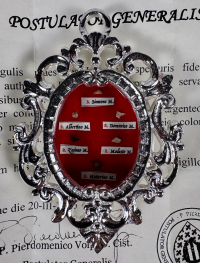
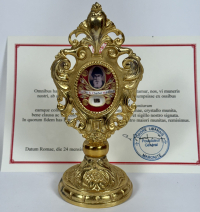
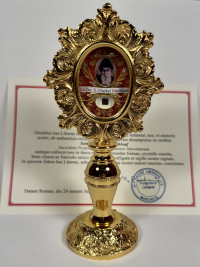
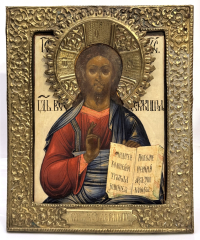
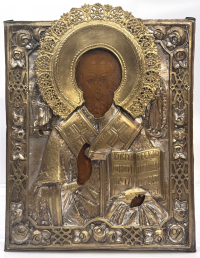
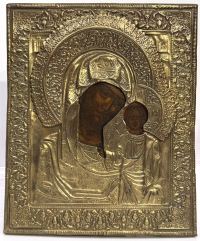
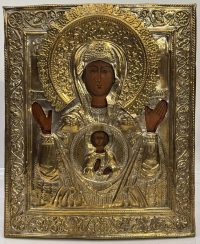
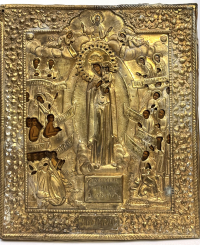

 Поменять язык на русский
Поменять язык на русский 